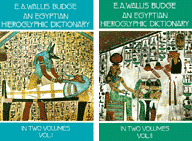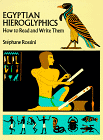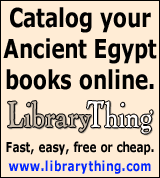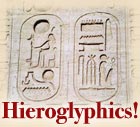Learning Hieroglyphics
In distinguishing between resources intended for serious students and those for casual students I am not criticizing the intelligence of the casual students or of the authors of pages designed for their use. As I see it, the casual student is interested primarily in the writing system. He or she wants to learn something about how this system works and learn a few signs, probably in order to produce or recognize names. The serious student desires to understand the full writing system in all its complexity and to wade into the language itself. As long as the casual student is not deluded into thinking that a command of a few dozen signs renders him capable of translating Egyptian texts there are good reasons for such study.
Web Archive: Glyphs and Grammars, Resources for beginners, compiled by Aayko Eyma. Textbooks in various languages are discussed, with a list of online-resources at the end. See also Part II, for advanced students.
Serious Students
 Amazon.
How to Read Egyptian Hieroglyphs : A Step-By-Step Guide to Teach Yourself by Mark Collier and Bill Manley. Ultimately, this is a serious book for people who want to tackle the language itself, not just learn about the language or learn to recognize a few hieroglyphs. Individuals learn differently and will always differ on the best textbooks, but for me this book offers the best comprimise between hard work and rewards. A number of (generally favorable)
reviews by scholars have been brought together at the Ancient Egyptian Language discussion group.
Amazon.
How to Read Egyptian Hieroglyphs : A Step-By-Step Guide to Teach Yourself by Mark Collier and Bill Manley. Ultimately, this is a serious book for people who want to tackle the language itself, not just learn about the language or learn to recognize a few hieroglyphs. Individuals learn differently and will always differ on the best textbooks, but for me this book offers the best comprimise between hard work and rewards. A number of (generally favorable)
reviews by scholars have been brought together at the Ancient Egyptian Language discussion group.
Reading Egyptian Hieroglyphs: A Bibliography for Beginners, by Gayle Gibson for the Royal Ontario Museum. Detailed annotated bibliography for serious students of varying ages. Her top recommendations are Zauzich's Hieroglyphs Without Mystery and my favorite, Collier and Manley, How to Read Egyptian Hieroglyphs. The Egyptology section also has an Ask an Egyptologist page.
Jim Loy's hieroglyphic dictionary. Capable and hugely energic amateur's working dictionary.
A Short Introduction to Hieroglyphs by Serge Rosmorduc. Work in progress covers the writing system and some basic grammar. In my opinion, the hieroglyphic images used are too small for the job. See Rosmorduc's homepage for more hieroglyphics material.
 Amazon.
An Egyptian Hieroglyphic Dictionary by E. A. Wallis Budge. Although frequently reprinted, Budge's books are now over 100 years old. Goeffrey Graham, a Yale graduate student, wrote a
balanced discussion of their defects and their uses for the Ancient Egyptian Language Discussion List.
Amazon.
An Egyptian Hieroglyphic Dictionary by E. A. Wallis Budge. Although frequently reprinted, Budge's books are now over 100 years old. Goeffrey Graham, a Yale graduate student, wrote a
balanced discussion of their defects and their uses for the Ancient Egyptian Language Discussion List.
Reading Hieroglyphs - The First Steps from Egyptologica Vlaanderen VZW On-Line. Although only the "first steps" are covered, they are covered with an eye to further, rigorous study.
A Little Egyptian Reading Book by Stephen Fryer. Learn Egyptian by doing.
Amazon. Sir Alan Gardiner's Egyptian Grammar. Serious teaching and reference grammar. Amazon reviewers differ:
Gardiner's book was a true ground-breaker in this field. It is now badly in need of revision and updates, and its antiquated style makes it extremely hard to follow, with or without a teacher. It's high time some brave soul wrote a new Egyptian grammar that was up to date, clear, easy to read, and based on more modern pedagogical theories.
Reply: Gardiner's grammar is the best available combination of a didactic and reference grammar of Hieroglyphics. We don't need new grammars; we need students prepared to work hard to master a difficult language. There are no easy roads to the mastery of Egyptian.
The Beinlich wordlist, An Internet-searchable database developed by Nigel Strudwick. The Beinlich wordlist is a sort of dictionary of Egyptian words. The dictionary can be searched (by transliteration) but not viewed in other ways. Translations are in German.
Paul Sciortino, a Perl programmer, rescued this useful resource from oblivion. From one Perl programmer to another, good work! (Editor)
Web Archive: Unofficial key to the translation exercises in Sir Alan Gardiner's Egyptian Grammar by Mark-Jan Nederhof.
Web Archive: Hieroglyphic index to Faulkner's dictionary facilitates looking up words with unknown signs in Faulkner's A Concise Dictionary of Middle Egyptian. Developed by Marc Line.
Web Archive: Unofficial key to the exercises in B.G. Ockinga's A Concise Grammar of Middle Egyptian (1998) by Mark-Jan Nederhof.
Champollion, Grammaire Egyptienne. Electronic text of his 1836 grammar. Now a monument in intellectual history rather than a useful resource.
Casual Students
 Amazon.
Egyptian Hieroglyphics: How to Read and Write Them by Stephane Rossini. A somewhat more elementary book than Collier and Manley's
How to Read Egyptian Hieroglyphs or, as one reviewer put it:
Amazon.
Egyptian Hieroglyphics: How to Read and Write Them by Stephane Rossini. A somewhat more elementary book than Collier and Manley's
How to Read Egyptian Hieroglyphs or, as one reviewer put it:
This book is almost all illustrations. Contains a short summary explaining grammar, though not in-depth. Good sign list, also shows how to draw glyphs. Might be good as a reference, but for serious student it will not stand alone.
Web Archive: Learn Egyptian Hieroglyphics. Covers 1-consonant signs. Intended for children, but dumbs it down less than some pages.
Guide to writing hieroglyphs. Artist Jenny Carrington's guide to drawing hieroglyphs quickly and beautifully. Check out her homepage for works based on Egyptian paintings and Greek vases.
 Amazon.
Understanding Hieroglyphs : A Complete Introductory Guide by Hilary Wilson. The Amazon review hits the nail on the head:
Amazon.
Understanding Hieroglyphs : A Complete Introductory Guide by Hilary Wilson. The Amazon review hits the nail on the head:
I'm really in two minds about this book. The title suggests that it is a book about hieroglyphs, and a quick look through it seems to confirm that impression. On reading the book, however, it turns out that only the 1-consonant form is covered, there's nothing about determinatives (really?), there is no grammar to speak of, and that the illustrations from Egyptian inscriptions, although translated, are seldom if ever described in the detail I think a student needs (such as the variant writing Djedju for Djedu, which had me puzzled until I read Collier and Manley's book "How to read Egyptian", which may be more suited to a reader who wants to get involved with the language rather than the letters or symbols it is written with).
Other Egyptian Writing Systems
The Coptic Language. History of Coptic together with a basic self-teaching course by Hany N. Takla. Includes Antonious Coptic font.
Hieratic lessons from Stephen Fryer. Knowledge of hieroglyphic essential.
Web Archive: The Hieratic Font Project, China. It's difficult to pin this project down.
Once You Know / Academic
The Language of Ancient Egypt by Jacques Kinnaer, from his enormous and high-quality Ancient Egypt Site. Mr. Kinnaer nicely straddles the academic and the popular, writing for the intelligent layman. His site includes a very comprehensive list of Egyptological sites.
Centre for Computer-Aided Egyptological Research devoted to Utrecht University.
Hieroglyphic texts/Textes hieroglyphiques. Serge Rosmorduc's collection of texts, transliterations and translations. See Rosmorduc's homepage for other hieroglyphics-related material.
Gardiner's Sign List. Images from Sir Alan Gardiner's seminal sign tables.
Sample Text: The Instruction of Ptahhotep. Wisdom literature in hieroglyphic transcription, transliteration and translation. Entered by Matt Whealton.

All material © 2000–2004 Tim Spalding.
Presented in Association with Amazon.
If you enjoy this site you may also like these other sites by me:
Cleopatra on the Web. Comprehensive website on Cleopatra VII of Egypt. Includes 168 images.
Alexander the Great on the Web. Links to over 1000 images and 200 images of Alexander.
Ancient Astrology and Divination on the Web. Reliable (non-kooky) information on ancient (primarily Greco-Roman) astrology and divination.
The Complete Petra. Web directory and guide to the ancient city of Petra in southern Jordan.
